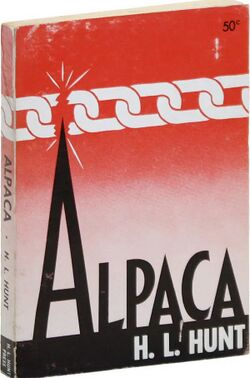The Rocklopedia Fakebandica now has a podcast.
Listen now!
Difference between revisions of "Mara Hani"
| Line 1: | Line 1: | ||
| − | [[Image:Hani_Mara_Alpaca.jpg|250px|right]]Star opera singer from the novel ''Alpaca'' by Texas oil billionare [https://en.wikipedia.org/wiki/H._L._Hunt H. L. Hunt] (Dallas : H.L. Hunt Press, 1960). She | + | [[Image:Hani_Mara_Alpaca.jpg|250px|right]]Star opera singer from the novel ''Alpaca'' by Texas oil billionare [https://en.wikipedia.org/wiki/H._L._Hunt H. L. Hunt] (Dallas: H.L. Hunt Press, 1960). She is from the fictional country of Alpaca, which Hunt used to describe his ideal form of government where rich people get extra votes. |
<blockquote> | <blockquote> | ||
| Line 11: | Line 11: | ||
==External Links== | ==External Links== | ||
*https://babel.hathitrust.org/cgi/pt?id=mdp.39015073444443&seq=5 | *https://babel.hathitrust.org/cgi/pt?id=mdp.39015073444443&seq=5 | ||
| + | |||
| + | [[Category:Opera|Hani, Mara]] | ||
| + | [[Category:1960|Hani, Mara]] | ||
| + | [[Category:Fictional singers|Hani, Mara]] | ||
Latest revision as of 14:05, 25 January 2024
Star opera singer from the novel Alpaca by Texas oil billionare H. L. Hunt (Dallas: H.L. Hunt Press, 1960). She is from the fictional country of Alpaca, which Hunt used to describe his ideal form of government where rich people get extra votes.
When at long last the dancers had danced every conceivable figure from adagio to tarantella, from cakewalk to tango, and had tirelessly taken their encores, a soft rustle of expectation and subdued excitement swept through the house; it was time for the fairytale singer to perform. The small orchestra in the miniature pit laid scores on racks . The conductor raised his baton. Dark blue plush curtains parted and there, against a huge mirrored back-drop, stood a slim erect vision of femininity, with exquisite coiffure above an oval face, and long-lashed eyes that were limpid pools of mystery and witchery unparalleled.
She wore an ankle-length, tight sheath of velvet in crushed-raspberry color which accented her flawless complexion, displaying perfect arms and shoulders. All twenty nails were painted to match her gown. A rope of diamonds circled her tiny waist and on her head rested a triumph of the jeweler's art, a tiara of diamonds set in delicate filigree. On her feet were slender high-heeled plastic slippers, suggestive of Cinderella's fabled glass footwear. All this richness of setting was as nothing compared to the authentic, living beauty at its focal point. The audience caught its breath, broke into a spontaneous ripple of applause which subsided as Mara began to sing.
Who could describe that lilting voice, powerful, true and sweet; expressing all the emotion implicit in the aria; a voice not forced, never sacrificing the tender innocent naivete of lovely, pathetic Lucia? Next day, the critics of the press were to exhaust their adjectives in adulation. That night, listeners knew they were witnessing opera history in the making. An awed moment of stillness followed the final double-bar; then, applause was thunderous. She took bow after bow; it was evident that even to gaze upon Mara's fresh glowing young beauty was a thing to dazzle this select group of jaded Parisians, while talent, added to charm , proved an intoxicating draught.
